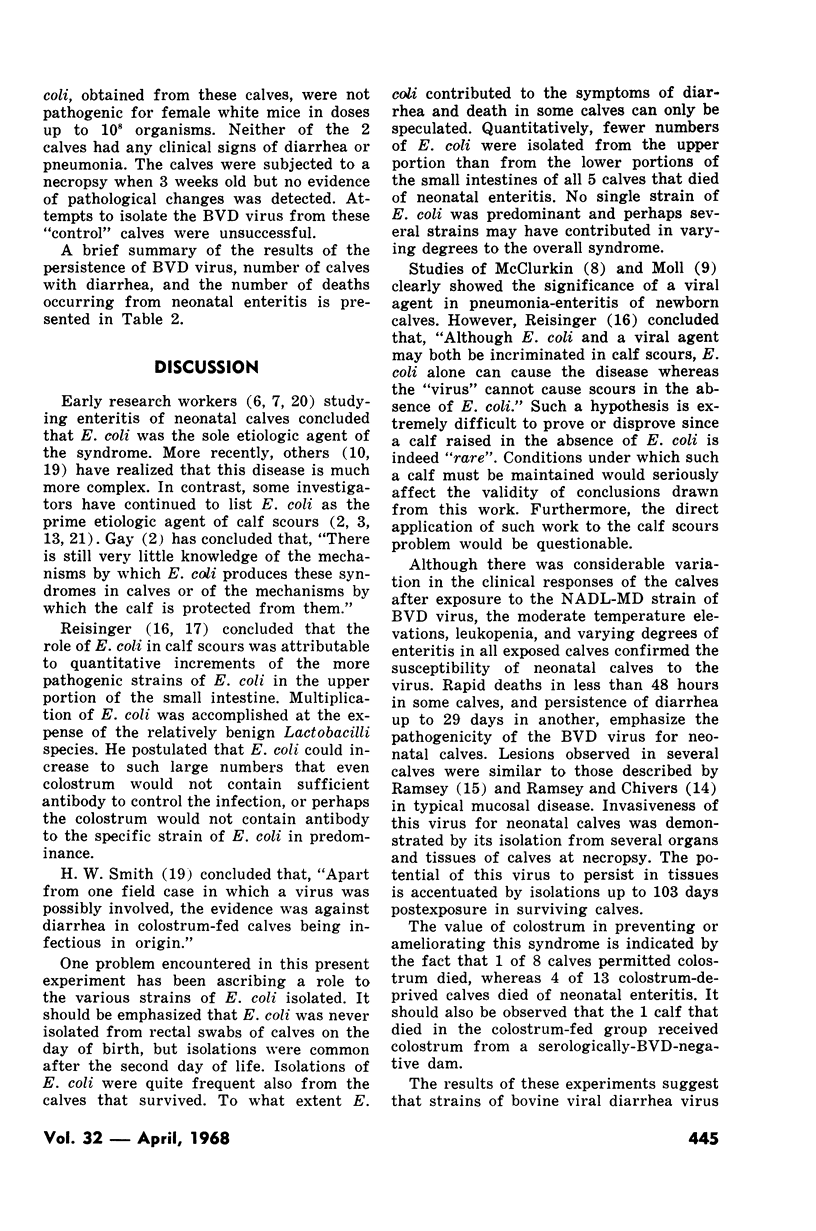Abstract
This study was initiated to determine the etiologic and pathogenic significance of an American strain of bovine viral diarrhea (BVD) virus (strain NADL-MD) in enteritis of neonatal calves (calf scours).
Three colostrum-fed calves from dams exposed intravenously to BVD virus at 6, 16 and 25 days prepartum, respectively, had moderate diarrhea persisting until the eighth day of life. The BVD virus was isolated from all 3 calves and persisted up to 93 days in 1 calf, indicating either that BVD was transmitted in utero or via the dam's milk.
Three specific pathogen free (SPF) calves permitted dams' colostrum for the first 4 feedings and then given milk replacer were exposed orally on the day of birth to BVD virus. One calf died of neonatal enteritis 28 hours post-exposure and at necropsy the BVD virus was isolated from several of its organs. The remaining 2 calves had a mild diarrhea persisting to the eighth day of age.
Two calves permitted dams' colostrum ad lib. for 72 hours, and then weaned, were exposed orally to BVD virus. Both calves had a mild persistent diarrhea and BVD virus was isolated from their blood for 56 days post-exposure.
Of 13 SPF, colostrum-deprived calves exposed orally or intranasally at birth to the BVD virus, 4 had severe diarrhea and died of neonatal enteritis from 38 hours to 13 days postexposure. Isolations of BVD virus were made from several of the organs of the calves at necropsy. All of the 9 surviving calves had a moderate to severe diarrhea frequently persisting for 7 to 10 days, and BVD virus was isolated from the survivors up to 103 days postexposure.
Several strains of Escherichia coli were isolated from calves after the second day of life, but were neither pathogenic for mice, nor serologically related to strains of E. coli usually associated with outbreaks of calf scours. Four colostrum-deprived SPF calves were exposed orally at birth to a strain of E. coli isolated from the intestine of the calf with the most acute symptoms and fatal neonatal enteritis. None of the four calves receiving the E. coli had diarrhea. One calf, however, had respiratory distress and died on day 5.
Two SPF colostrum-deprived control calves had neither diarrhea nor respiratory distress.
The above findings support the conclusion that BVD virus should not be overlooked as a primary cause of the neonatal calf enteritis complex.
Full text
PDF






Selected References
These references are in PubMed. This may not be the complete list of references from this article.
- GAY C. C. ESCHERICHIA COLI AND NEONATAL DISEASE OF CALVES. Bacteriol Rev. 1965 Mar;29:75–101. doi: 10.1128/br.29.1.75-101.1965. [DOI] [PMC free article] [PubMed] [Google Scholar]
- Gutekunst D. E., Malmquist W. A. Complement-Fixing And Neutralizing Antibody Response To Bovine Viral Diarrhea And Hog Cholera Antigens. Can J Comp Med Vet Sci. 1964 Jan;28(1):19–23. [PMC free article] [PubMed] [Google Scholar]
- Moll T. The pathogenesis of diarrhea in the newborn calf, with special reference to physiologic functions and environmental conditions. J Am Vet Med Assoc. 1965 Dec 15;147(12):1364–1366. [PubMed] [Google Scholar]
- Reisinger R. C. Pathogenesis and prevention of infectious diarrhea (scours) of newborn calves. J Am Vet Med Assoc. 1965 Dec 15;147(12):1377–1386. [PubMed] [Google Scholar]
- Romváry J. Incidence of virus diarrhoea among newborn calves. Acta Vet Acad Sci Hung. 1965;15(3):341–347. [PubMed] [Google Scholar]
- SMITH H. W. Observations on the aetiology of neonatal diarrhoea (scours) in calves. J Pathol Bacteriol. 1962 Jul;84:147–168. [PubMed] [Google Scholar]


